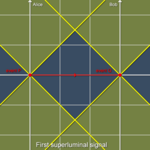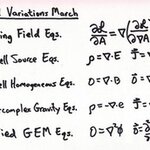Physics

Although I went on record that the reportedly faster than light neutrinos from CERN to OPERA will likely go away as mere systematic error, and although my very own resolution of the EPR paradox rejects superluminal phenomena even in non-local quantum entanglement, it is nevertheless quite possible that speeding particles are here to stay and perhaps expected (especially with neutrinos) for a number of reasons.
After listing those reasons, I will remark on one of the common reactions against open-mindedness concerning the neutrino experiments. Next to “you are nuts” is the charge about hedging…
Tomorrow is the last day on duty. For twenty-six years the Tevatron collider, the four-mile-long accelerator of the Fermi laboratory in Batavia (IL), has provided the CDF and DZERO experiments with proton-antiproton collisions at 1.8 and then 1.96 Tera-electron-Volts, allowing the investigation of fundamental physics at the highest available energy.
I received today a very nice video which commemorates the Tevatron collider. The video was produced by a colleague, Rob Snihur, together with an artist friend of his, Maria Scileppi. I hope you like it! A text is also available on Maria's site.…

The article Neutrinos CAN go Faster than Light has triggered large interest and is at present widely discussed, for example here and here on my favorite (for variety and reliability) German science column Here There Be Dragons and somewhat here at Ethan’s always exciting startswithabang. The discussions however revolve around hypothetical extra dimensions, but extra dimensions are unnecessary:
Superluminal velocities do generally not violate relativity, or help you to time-travel, or violate causality as long as there is only a single reference frame relative to which the propagation happens…

Nature abhors a magnetic monopole, although she adores gravitational and electric monopoles. The homogeneous Maxwell equations are the ones that need no currents, known as the no magnetic monopoles and Faraday's laws. There are three ways to derive the homogeneous Maxwell equations. The first way is to use vector identities. This is the simplest approach, the one most widely used. Pick out a particular way to write the electric and magnetic field, and the job is done. The divergence of a curl is a long way to say zero. Define the magnetic field as a curl, then its divergence is zero, and…

The organizers of TEDx Flanders did produce in a very timely manner very professional videos of the event, so you can follow offline the talks, including mine. However, what I said is not exactly what I had planned to say. Further, you might not want to spend your time looking at a recording. So for the record, I am pasting here my unamended script. Later on I will also post here the slides I showed while talking, which cannot be seen in the video.
----------------------------------------------------------- Thousands of physicists, engineers, computer scientists, modern-age seers have…

The TEDx crew has been quite fast to make available on youtube the video of the presentation I gave together with Peter Woit in Antwerp yesterday. You can give a look at it here.
Unfortunately the slides are not simultaneously available, but I will fix that by pasting them here.
For now, just the video. Enjoy!
(By the way, my name has been misspelled in the title in a less than conventional way this time - but they're working to fix it).

Just about two days ago I warned that there will be a lot of nonsense about relativity coming out these days, and promptly there are already three articles here on Science2.0 alone that are exactly what I feared: Physicists with only basic knowledge about relativity claiming that particles cannot possibly go faster than light and portraying anybody who holds otherwise as a moron (not literally, but that seems to be the gist). Wake up guys – it is 2011 – modern physics has come a looooong way since Albert.
In modern physics, it is well understood how particles can travel with superluminal…
Yesterday's event at TEDx in Antwerp, in the gorgeous Flemish Opera, was followed by an enthusiastic audience of 1000. I spoke in the afternoon and tried to explain what it is that we do at CERN with these protons and the complicated machines we use. I must say I had never spoken in front of such a large audience (although I had played the fourth Brandemburg concerto by Bach a few times in front of similar numbers, but that was 30 years ago), and my heart rate went to about 160 for the whole duration of my speech. I went blank a couple of times (forgot the succession of things I wanted to say…

Do you believe neutrinos can exceed the universal speed limit of 299792.458 km/s? Be careful before you respond with "yes". Rumor has it that the set of all people who believe superluminal speeds have indeed been observed in the OPERA experiment is disjoint from the set of all people who have a deep understanding of relativity. (Which doesn't imply that any person unconvinced by the OPERA results necessarily understands relativity.)
Has the universal speed limit been violated? The OPERA results appear to indicate that the much discussed (see here for the blogpost breaking the news…

The people with the atom smashers, especially the ones at OPERA (Oscillation Project with E-tR Apparatus) in Italy’s Gran Sasso, announced to likely have a whopping 60 nano second systematic error with some neutrino experiments, but it makes for much better news to question Einstein. The scientists blame journalists for the hype, but of course they prepared everything just so that the press has no reason not to go ahead and make an Einstein spectacle out of it – the BBC promptly obliged. It is the usual ‘claim-to-be-fundamental-strategy’ as done with the God particle and all the other blown…